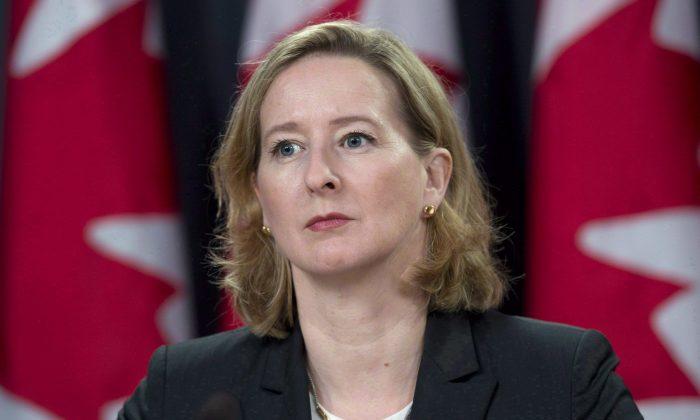OTTAWA—The sharp drop in oil prices has led to falling inflation and rate cuts by the Bank of Canada, but part of the bigger picture is that Canada’s labour market is in rough shape as the economy continues to underperform. What looked like a strong jobs report on Feb. 6 has some deep cracks beneath the surface and it could spur the central bank into cutting rates further.
In a speech to the Ottawa Economics Association at Chateau Laurier on Feb. 10, Bank of Canada senior deputy governor Carolyn Wilkins identified some undesirable characteristics in Canada’s labour market.
But she reiterated that the central bank is prepared to take further action, if needed, to boost the economy to reach its full potential while spurring inflation to get back to the 2 percent target. These results, combined with reaching full employment, are what economists call the “divine coincidence.”
One of the reasons the Canadian economy is operating below capacity is a labour market that has been struggling over the past six years since the onset of the financial crisis. In her speech, titled “Minding the Labour Gap,” Wilkins discussed how measuring slack specifically in the labour market shows greater unused capacity than do broader measures of slack.
The situation is that firms are producing more with less and as a result employment growth last year was less than it could have been. Job growth was about 10,000 a month in 2014, which is roughly 3,500 below potential.
Bad Trends
The Bank of Canada estimates that the excess capacity in the labour market—the “labour gap”—was about 1.5 percent at the end of last year—or roughly 270,000 jobs.
The Bank analyzed the labour gap and found that it is entirely composed of workers aged 15 to 54. This phenomenon established itself post financial crisis and is a turnaround from the prior 15 years where older workers (aged 55 and over) typically contributed the most to the labour gap.
So, the participation rate—the number of people who are either employed or are actively looking for work as a percentage of the total population—of prime age workers (aged 25-54) fell substantially in 2014.
The Bank also notes that more than 25 percent of people who have part-time jobs want full-time jobs, and the average hours worked remain low. While the unemployment rate is near its post-recession low, plenty of concerns remain about the labour market.
The Statistics Canada job report of Feb. 6 showed that full-time employment fell by 12,000 jobs and part-time employment rose by 47,000. This is an undesirable mix despite reaching a solid headline of 35,000 new jobs and a 6.6 percent unemployment rate.
Self-employment has been the dominant pattern as 46 percent of jobs over the past 12 months are of that variety. It also means firms are less interested in hiring.
Given this backdrop, wage inflation has been kept in check and is not contributing to overall inflation.
The Bank wants to get inflation back to the 2 percent target as this is consistent with the economy operating at potential and full employment in a normal business cycle.
“Setting the right monetary conditions, in the context of our inflation-targeting regime, is the best thing we can do for the labour market,” Wilkins said.
“The 2 percent inflation target is a means—it’s not the end,” Wilkins said. “It is the best contribution monetary policy can make to the economic and financial well-being of Canada.”
Climbing out of recession has been a long, drawn-out process and uncertainty still lingers, as the right kind of job creation is not taking place.
And the oil price plunge hasn’t yet taken effect in terms of official employment statistics, as Alberta reported employment jumping by nearly 14,000 in January. Wilkins noted that since oil prices were elevated until last summer, there is currently no labour slack in provinces west of Ontario and that all the labour market slack is in provinces east of Manitoba.
Wilkins said the Bank expects capital investment in the oil and gas sector to fall by 30 percent in 2015.
More Easing?
The indications are that the Bank of Canada is ready to act further. Wilkins emphasized that, “If potential output growth turns out to be lower than we think, we have the tools to bring inflation back to target.”
Her remark was similar to what deputy governor Tim Lane said in a Jan. 13 speech when he concluded with, “However things play out, we have the tools to respond.”
Financial markets didn’t really clue in to Lane’s comments and was caught napping when the Bank of Canada cut rates on Jan. 21, but Wilkins’ comments caused a reaction in the Canadian dollar, which fell in value against the U.S. currency by about a cent. Expectations also grew for a further cut in rates when the Bank meets on March 4.
These undesirable trends in the labour market won’t correct themselves in the short term, and weakness in Alberta’s job market has yet to hit. The Bank expects the economy to reach full capacity around the end of 2016, and for the divine coincidence to be re-established, most of the good things need to take place in the labour market.
Follow Rahul on Twitter @RV_ETBiz






Friends Read Free